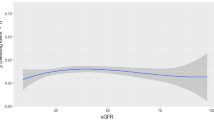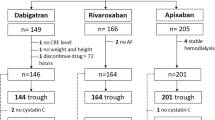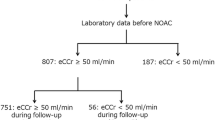Abstract
Prescription of non-vitamin K antagonist oral anticoagulants (NOACs) requires an assessment of renal function (RF) and the Cockcroft–Gault (CG) equation is traditionally recommended. The objective of the study was to evaluate the potential changes in NOACs management using different equations for estimating RF. In a post hoc analysis of a prospective cohort of patients with atrial fibrillation, we considered different equations: (1) CG for creatinine clearance (CrCl), (2) modification of diet in renal disease (MDRD), (3) CKD-EPI, (4) Berlin Initiative Study 1 (BIS-1) and (5) full age spectrum (FAS), for glomerular filtration rate (GFR). RF was classified according to CrCl in three categories: severely depressed (SD-RF) < 30 ml/min; moderately depressed (MD-RF) 30–49 ml/min; preserved/mildly depressed (P-RF) ≥ 50 ml/min. Concordances in the assignments were analyzed. A population of 402 patients (61.2% males, age 72 ± 11) was categorized according to CrCl: 12 patients (2.9%) as SD-RF, 81 (20.1%) as MD-RF, 309 (76.8%) as P-RF. A potential change in NOACs management could occur using GFR equations rather than CrCl in 16.9% of patients using MDRD formula, in 11.7% using BIS-1, in 14.7% using CKD-EPI and in 12.9% using the FAS equation. Important changes in RF estimates were more frequent in patients aged ≥ 75, but also BMI had a meaningful impact. Use of equations estimating GFR instead of the Cockcroft–Gault equation may result in changes in NOACs management in 12–17% of patients. In the elderly ≥ 75, more pronounced changes in RF classification are detectable according to different equations and NOACs dosing should be further investigated.
Similar content being viewed by others
References
Kirchhof P, Benussi S, Kotecha D et al (2016) 2016 ESC Guidelines for the management of atrial fibrillation developed in collaboration with EACTS. The Task Force for the management of atrial fibrillation of the European Society of Cardiology (ESC), Developed with the special contribution of the European Heart Rhythm Association (EHRA) of the ESC, endorsed by the European Stroke Organisation. Eur Heart J
Hart RG, Pearce LA, Aguilar MI (2007) Meta-analysis: antithrombotic therapy to prevent stroke in patients who have nonvalvular atrial fibrillation. Ann Intern Med 146:857–867
Connolly SJ, Ezekowitz MD, Yusuf S et al (2009) Dabigatran versus warfarin in patients with atrial fibrillation. N Engl J Med 361:1139–1151
Patel MR, Mahaffey KW, Garg J et al (2011) Rivaroxaban versus warfarin in nonvalvular atrial fibrillation. N Engl J Med 365:883–891
Granger CB, Alexander JH, McMurray JJ et al (2011) Apixaban versus warfarin in patients with atrial fibrillation. N Engl J Med 365:981–992
Giugliano RP, Ruff CT, Braunwald E et al (2013) Edoxaban versus warfarin in patients with atrial fibrillation. N Engl J Med 369:2093–2104
Ruff CT, Giugliano RP, Braunwald E et al (2014) Comparison of the efficacy and safety of new oral anticoagulants with warfarin in patients with atrial fibrillation: a meta-analysis of randomised trials. Lancet 383:955–962
Lip G, Freedman B, De Caterina R, Potpara TS (2017) Stroke prevention in atrial fibrillation: Past, present and future. Comparing the guidelines and practical decision-making. Thromb Haemost 117:1230–1239
Camm AJ, Lip GY, De Caterina R et al (2012) 2012 focused update of the ESC Guidelines for the management of atrial fibrillation: an update of the 2010 ESC Guidelines for the management of atrial fibrillation. Developed with the special contribution of the European Heart Rhythm Association. Eur Heart J 33:2719–2747
Devereaux PJ, Yang H, Yusuf S et al (2008) Effects of extended-release metoprolol succinate in patients undergoing non-cardiac surgery (POISE trial): a randomised controlled trial. Lancet 371:1839–1847
Heidbuchel H, Verhamme P, Alings M et al (2015) Updated European Heart Rhythm Association Practical Guide on the use of non-vitamin K antagonist anticoagulants in patients with non-valvular atrial fibrillation. Europace 17:1467–1507
Stevens LA, Coresh J, Greene T, Levey AS (2006) Assessing kidney function–measured and estimated glomerular filtration rate. N Engl J Med 354:2473–2483
(2013) KDIGO 2012 clinical practice guideline for the evaluation and management of chronic kidney disease. Kidney international 3:1–150
Lip GYH, Collet JP, Caterina R et al (2017) Antithrombotic therapy in atrial fibrillation associated with valvular heart disease: a joint consensus document from the European Heart Rhythm Association (EHRA) and European Society of Cardiology Working Group on Thrombosis, endorsed by the ESC Working Group on Valvular Heart Disease, Cardiac Arrhythmia Society of Southern Africa (CASSA), Heart Rhythm Society (HRS), Asia Pacific Heart Rhythm Society (APHRS), South African Heart (SA Heart) Association and Sociedad Latinoamericana de Estimulación Cardíaca y Electrofisiología (SOLEACE). Europace 19:1757–1758
Cockcroft DW, Gault MH (1976) Prediction of creatinine clearance from serum creatinine. Nephron 16:31–41
Levey AS, Bosch JP, Lewis JB, Greene T, Rogers N, Roth D (1999) A more accurate method to estimate glomerular filtration rate from serum creatinine: a new prediction equation. Modification of Diet in Renal Disease Study Group. Ann Intern Med 130:461–470
Levey AS, Stevens LA, Schmid CH et al (2009) A new equation to estimate glomerular filtration rate. Ann Intern Med 150:604–612
Schaeffner ES, Ebert N, Delanaye P et al (2012) Two novel equations to estimate kidney function in persons aged 70 years or older. Ann Intern Med 157:471–481
Pottel H, Hoste L, Dubourg L et al (2016) An estimated glomerular filtration rate equation for the full age spectrum. Nephrol Dial Transplant 31:798–806
Rostoker G, Andrivet P, Pham I, Griuncelli M, Adnot S (2007) A modified Cockcroft-Gault formula taking into account the body surface area gives a more accurate estimation of the glomerular filtration rate. J Nephrol 20:576–585
Viera AJ, Garrett JM (2005) Understanding interobserver agreement: the kappa statistic. Fam Med 37:360–363
Shrout PE, Fleiss JL (1979) Intraclass correlations: uses in assessing rater reliability. Psychol Bull 86:420–428
(1998) Food and Drug Administration: guidance for industry: pharmacokinetics in patients with impaired renal function— study design, data analysis, and impact on dosing and labeling. Department of Health and Human Services, Rockville, May. https://www.fda.gov/downloads/drugs/guidances/ucm204959.pdf
Cirillo M, Anastasio P, De Santo NG (2005) Relationship of gender, age, and body mass index to errors in predicted kidney function. Nephrol Dial Transplant 20:1791–1798
Stevens LA, Nolin TD, Richardson MM et al (2009) Comparison of drug dosing recommendations based on measured GFR and kidney function estimating equations. Am J Kidney Dis 54:33–42
Michels WM, Grootendorst DC, Verduijn M, Elliott EG, Dekker FW, Krediet RT (2010) Performance of the Cockcroft-Gault, MDRD, and new CKD-EPI formulas in relation to GFR, age, and body size. Clin J Am Soc Nephrol 5:1003–1009
Boriani G, Savelieva I, Dan GA et al (2015) Chronic kidney disease in patients with cardiac rhythm disturbances or implantable electrical devices: clinical significance and implications for decision making-a position paper of the European Heart Rhythm Association endorsed by the Heart Rhythm Society and the Asia Pacific Heart Rhythm Society. Europace 17:1169–1196
January CT, Wann LS, Alpert JS et al (2014) 2014 AHA/ACC/HRS guideline for the management of patients with atrial fibrillation: a report of the American College of Cardiology/American Heart Association Task Force on Practice Guidelines and the Heart Rhythm Society. J Am Coll Cardiol 64:e1–76
Kakkar AK, Mueller I, Bassand JP et al (2013) Risk profiles and antithrombotic treatment of patients newly diagnosed with atrial fibrillation at risk of stroke: perspectives from the international, observational, prospective GARFIELD registry. PLoS One 8:e63479
Olesen JB, Lip GY, Kamper AL et al (2012) Stroke and bleeding in atrial fibrillation with chronic kidney disease. N Engl J Med 367:625–635
Boriani G, Laroche C, Diemberger I et al (2016) Glomerular filtration rate in patients with atrial fibrillation and 1-year outcomes. Sci Rep 6:30271
Fanikos J, Burnett AE, Mahan CE, Dobesh PP (2017) Renal function considerations for stroke prevention in atrial fibrillation. Am J Med 130(9):1015–1023
Lip GY, Andreotti F, Fauchier L et al (2011) Bleeding risk assessment and management in atrial fibrillation patients: a position document from the European Heart Rhythm Association, endorsed by the European Society of Cardiology Working Group on Thrombosis. Europace 13:723–746
Manzano-Fernández S, Andreu-Cayuelas JM, Marín F et al (2015) Comparison of estimated glomerular filtration rate equations for dosing new oral anticoagulants in patients with atrial fibrillation. Rev Esp Cardiol (Engl Ed) 68:497–504
NKDEP (2010) NKDEP. National Kidney Disease Education Program. Chronic kidney disease and drug dosing: information for providers. http://www.nkdep.nih.gov/professionals/CKD_DrugDosing_508.pdf
(2010) US Food and Drug Administration (2010). Draft guidance for industry: pharmacokinetics in patient with impaired kidney function—study design DA, and impact on dosing and labeling. http://www.fda.gov/downloads/Drugs/GuidanceComplianceRegulatoryInformation/Guidances/UCM204959.pdf
Levey AS, Coresh J, Balk E et al (2003) National Kidney Foundation practice guidelines for chronic kidney disease: evaluation, classification, and stratification. Ann Intern Med 139:137–147
Hawkins NM, Jhund PS, Pozzi A et al (2016) Severity of renal impairment in patients with heart failure and atrial fibrillation: implications for non-vitamin K antagonist oral anticoagulant dose adjustment. Eur J Heart Fail 18:1162–1171
Stevens LA, Levey AS (2009) Measured GFR as a confirmatory test for estimated GFR. J Am Soc Nephrol 20:2305–2313
Author information
Authors and Affiliations
Corresponding author
Ethics declarations
Conflict of interest
None.
Statements on human and animal rights
The study had been approved by the appropriate institutional research ethics committee. All procedures performed in the study involving human participants were in accordance with the ethical standards of the institutional and/or national research committee and with the 1964 Helsinki declaration and its later amendments or comparable ethical standards.
Informed consent
Informed consent was obtained from all individual participants included in the study.
Additional information
Gregory Yoke Hong Lip and Giuseppe Boriani are joint senior authors.
Electronic supplementary material
Below is the link to the electronic supplementary material.
Rights and permissions
About this article
Cite this article
Malavasi, V.L., Pettorelli, D., Fantecchi, E. et al. Variations in clinical management of non-vitamin K antagonist oral anticoagulants in patients with atrial fibrillation according to different equations for estimating renal function. Intern Emerg Med 13, 1059–1067 (2018). https://doi.org/10.1007/s11739-018-1857-3
Received:
Accepted:
Published:
Issue Date:
DOI: https://doi.org/10.1007/s11739-018-1857-3




